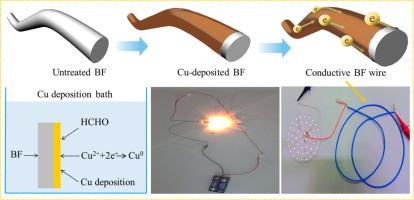Electroless copper-deposited basalt fibers with light-weight, high conductivity, and corrosion-resistance for next-generation communication networks
IF 5.7
3区 材料科学
Q2 MATERIALS SCIENCE, MULTIDISCIPLINARY
引用次数: 0
Abstract
The increasing demand for high-performance materials in advanced technological applications, such as next-generation communication networks and efficient energy transmission, necessitates materials with enhanced mechanical, electrical, and corrosion properties. To address this, this study presents surface-modified basalt fibers (BFs) achieved through a novel, precisely controlled electroless copper (Cu) deposition, resulting in enhanced properties. The electroless Cu deposition onto BFs was optimized by varying the deposition temperature (20–60 °C) to maximize electrical conductivity and tensile strength. An optimal deposition temperature of 50 °C yielded desirable properties, with microstructural analysis confirming a dense, highly crystalline Cu deposition that exhibited a high tensile strength of 1561 ± 320 MPa and a direct current (DC) electrical conductivity of 9.63 × 107 S/m, surpassing that of commercial Cu (5.96 × 107 S/m) and Ag (6.30 × 107 S/m). The corrosion behavior, evaluated by immersion testing in 5 v/v% sulfuric acid (H2SO4), indicated minimal corrosion. This surface modification also resulted in a significantly lower density of 3.34 g/cm³ (post-corrosion at 50 °C) compared to bulk Cu (8.96 g/cm³) and alternating current (AC) conductivities of 3.88 × 107 and 1.86 × 107 S/m (at 0.2 and 0.5 MHz, respectively). Consequently, these light-weight, sustainable materials demonstrate significant potential as alternatives to conventional Cu in applications demanding high conductivity, mechanical strength, and corrosion resistance, such as fifth-generation (5G) and future sixth-generation (6G) telecommunications, aerospace, and light-weight wires for power transmission.

化学镀铜玄武岩纤维,重量轻,电导率高,耐腐蚀,适用于下一代通信网络
在下一代通信网络和高效能源传输等先进技术应用中,高性能材料的需求日益增长,这就需要具有增强机械、电气和腐蚀性能的材料。为了解决这个问题,本研究提出了通过一种新颖的、精确控制的化学铜(Cu)沉积来获得表面改性玄武岩纤维(BFs),从而提高了性能。通过改变沉积温度(20-60°C),优化了BFs上的化学镀Cu,使其电导率和抗拉强度最大化。最佳沉积温度为50°C,获得了理想的性能,显微结构分析证实了致密,高结晶的Cu沉积,具有1561±320 MPa的高抗拉强度和9.63 × 107 S/m的直流(DC)电导率,超过了商用Cu (5.96 × 107 S/m)和Ag (6.30 × 107 S/m)。通过在5 v/v%硫酸(H2SO4)中浸泡测试,腐蚀行为表明腐蚀最小。与大块Cu (8.96 g/cm³)和交流(AC)电导率(分别为3.88 × 107和1.86 × 107 S/m)(分别为0.2和0.5 MHz)相比,这种表面改性还显著降低了密度(50°C腐蚀后),为3.34 g/cm³。因此,这些轻质、可持续的材料在要求高导电性、机械强度和耐腐蚀性的应用中,如第五代(5G)和未来的第六代(6G)电信、航空航天和电力传输的轻质电线,显示出替代传统铜的巨大潜力。
本文章由计算机程序翻译,如有差异,请以英文原文为准。
求助全文
约1分钟内获得全文
求助全文
来源期刊

Materials Research Bulletin
工程技术-材料科学:综合
CiteScore
9.80
自引率
5.60%
发文量
372
审稿时长
42 days
期刊介绍:
Materials Research Bulletin is an international journal reporting high-impact research on processing-structure-property relationships in functional materials and nanomaterials with interesting electronic, magnetic, optical, thermal, mechanical or catalytic properties. Papers purely on thermodynamics or theoretical calculations (e.g., density functional theory) do not fall within the scope of the journal unless they also demonstrate a clear link to physical properties. Topics covered include functional materials (e.g., dielectrics, pyroelectrics, piezoelectrics, ferroelectrics, relaxors, thermoelectrics, etc.); electrochemistry and solid-state ionics (e.g., photovoltaics, batteries, sensors, and fuel cells); nanomaterials, graphene, and nanocomposites; luminescence and photocatalysis; crystal-structure and defect-structure analysis; novel electronics; non-crystalline solids; flexible electronics; protein-material interactions; and polymeric ion-exchange membranes.
 求助内容:
求助内容: 应助结果提醒方式:
应助结果提醒方式:


